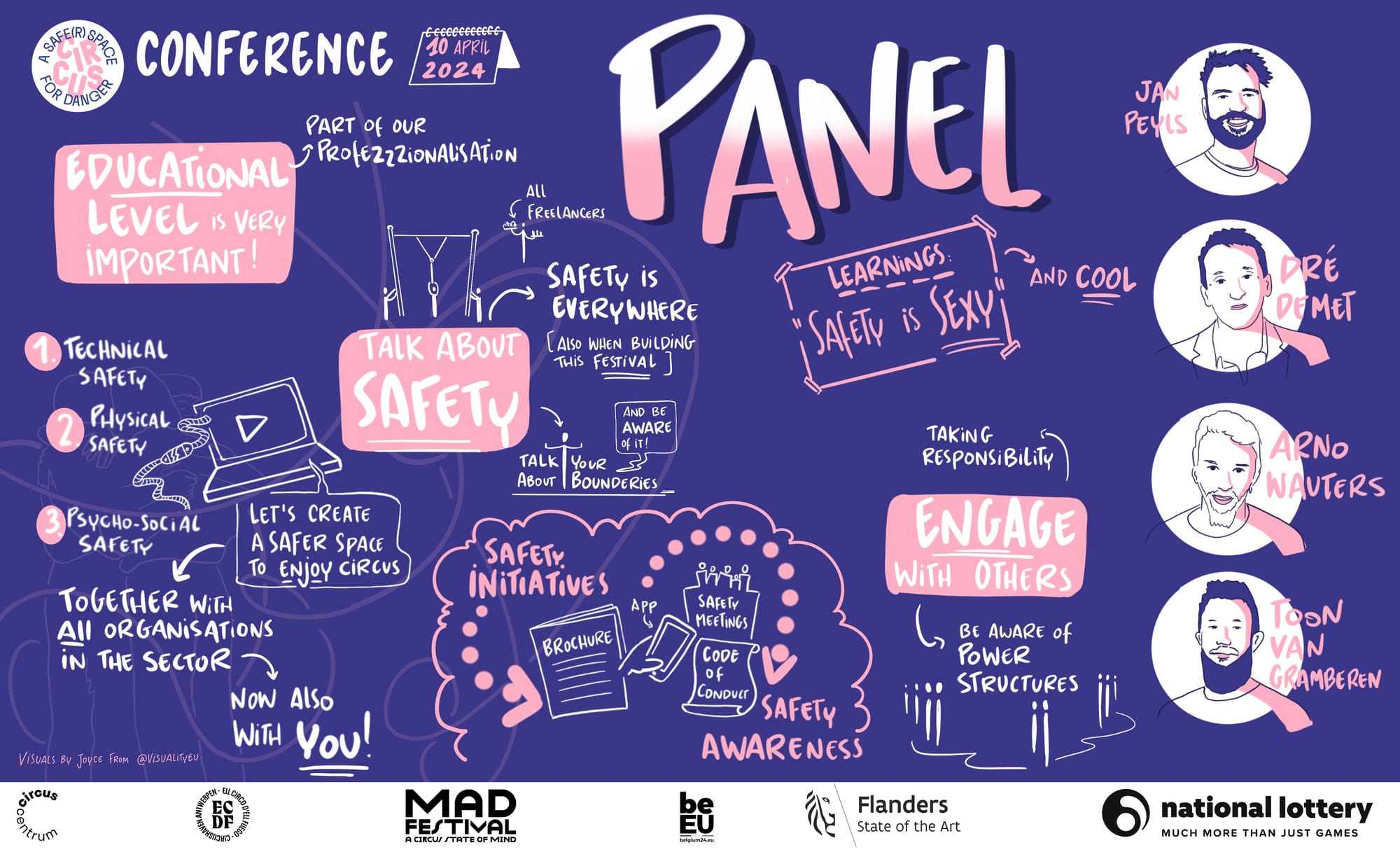Safety is more than an attitude. Where do we stand after two years of the safety drive?
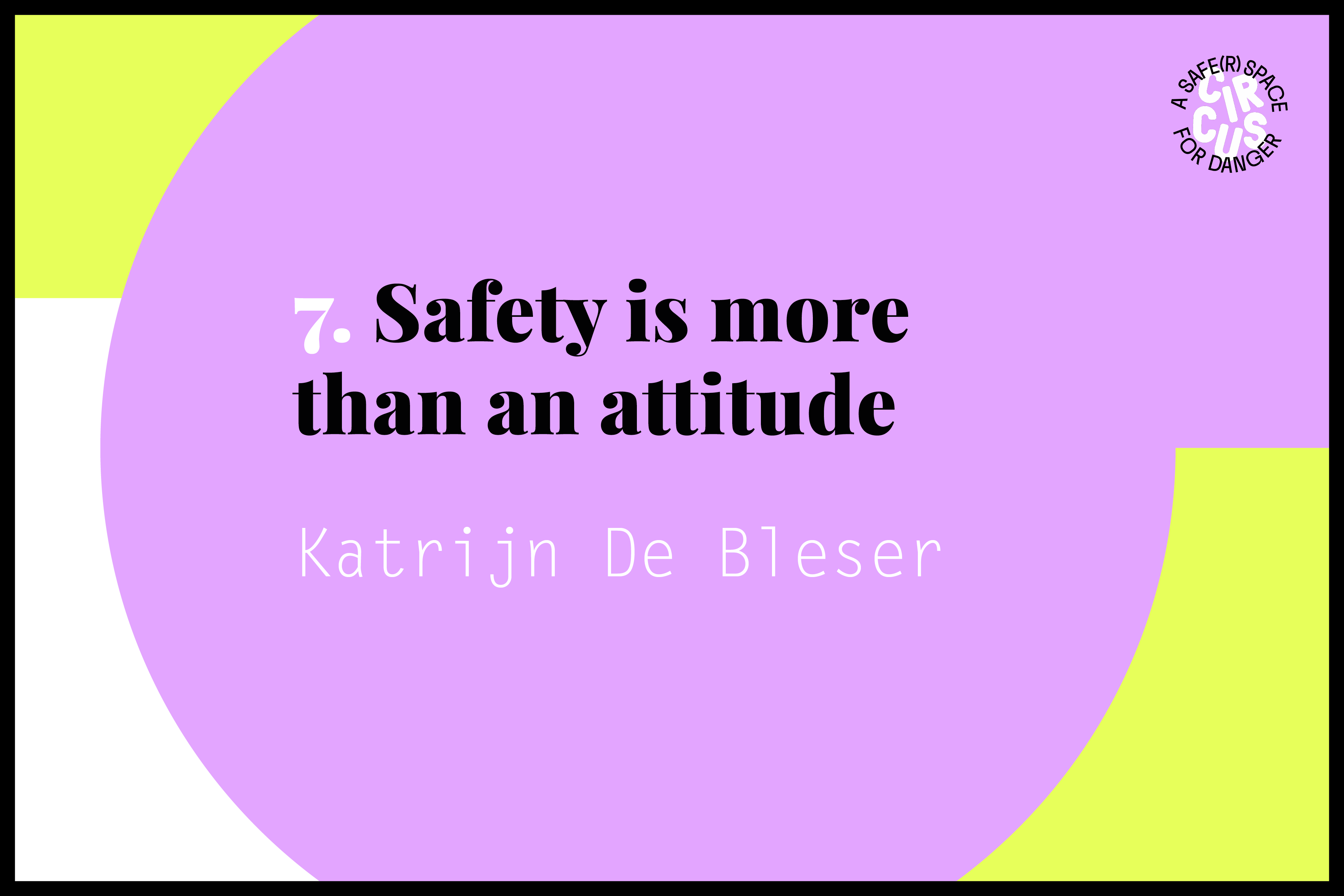
Safety is crucial in a sector known to have inherent risks. The international conference Circus – a safe(r) space for danger served as an anchor point in an initiative that had been ongoing for quite some time and that is still underway. (Will it ever be truly ‘done’?) This article by Katrijn De Bleser offers an update on the progress of the safety drive within the Flemish circus sector, providing insight into how the initiative quickly grew beyond the boundaries of the sector and the impact it’s having today.
an overview of the safety drive within the Flemish circus sector by Circuscentrum
In an initial phase of the safety drive, which was launched in 2022, the emphasis lay on the technical, physical and psychosocial safety of circus-educational operations. The pioneers taking part in the initiative included the larger youth circuses in Flanders in collaboration with Circuscentrum. Read more about the first part of the initiative here. This year, an initial measurement was made of the impact of this part of the initiative. See the info box below.*
Interest in the safety drive soon grew beyond the educational sector, with its scope broadening to include artistic operations. Performance companies, artists, festivals and circus creation centres were actively invited to participate in the project. With a view to making the project even more sustainable, a collaboration was established with the Performing Arts Social Fund (PASF), which opened the initiative up to the performing arts sector as a whole.
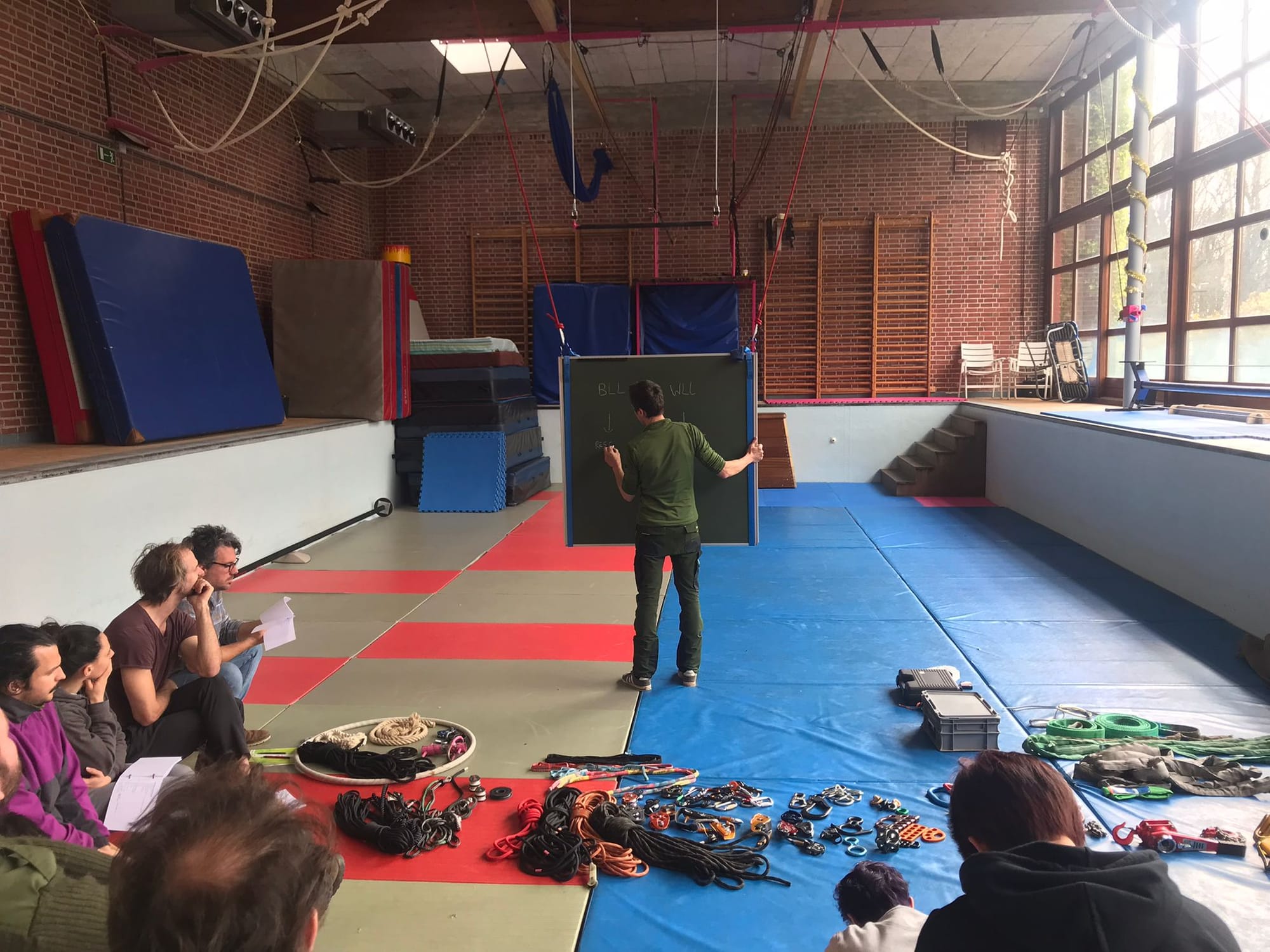
Circus and the Performing Arts Social Fund – an alliance for safety
How did the collaboration between the circus sector and the Performing Arts Social Fund (PASF) come about? ‘On a circus sector day Circuscentrum organised, we noticed that there was an overlap between the topics the PASF was engaged in and those relevant to the circus sector,’ says Christa Criel, employment and organisational psychologist at the PASF. ‘Because my work entails a focus on everything related to inappropriate behaviour and stress, the drive for psychosocial safety immediately jumped out at me. Of course, that is just one part of the bigger picture, namely well-being policy, which also includes physical safety.’
After some introductory discussions, it became clear that the PASF and the circus sector could complement and strengthen each other with regard to their safety expertise. ‘In circus there was already an in-depth training course on rigging and technical safety, and there was already a great deal of expertise in the circus sector relating to physical safety. And the PASF already had the training course for becoming a well-being officer, a role that is more about psychosocial safety. In addition to that, we recently developed a level-three prevention officer training course that is tailored to the sector. It was last year, to be exact, that we organised the prevention officer course, and there was immediate interest from a number of participants from the circus sector. We also had participants from the circus sector in our well-being officer course.’
The rigging course that was developed within the circus-education sector first went on to be offered by the PASF in the spring of 2024. The participants still included a lot of people from the circus sector (from small youth circuses to large festivals), as well as people from all corners of the performing arts sector. ‘Although the training is based on circus rigging, a lot of the techniques are also implemented in theatre. In the autumn of 2024, there will also be a first-aid course, originally devised with circus artists in mind but now offered to a broader audience. This kind of training, which is very much based on injury prevention, can also be of interest to participants from other subsectors, like dance. This may pose a challenge when it comes to the communication surrounding the course.’
And how is the collaboration proceeding? ‘We are still searching for ways to optimise our collaboration. It’s clear that safety in all its forms is an important topic in the sector and the interest in it did not develop from the top down but from the bottom up.’
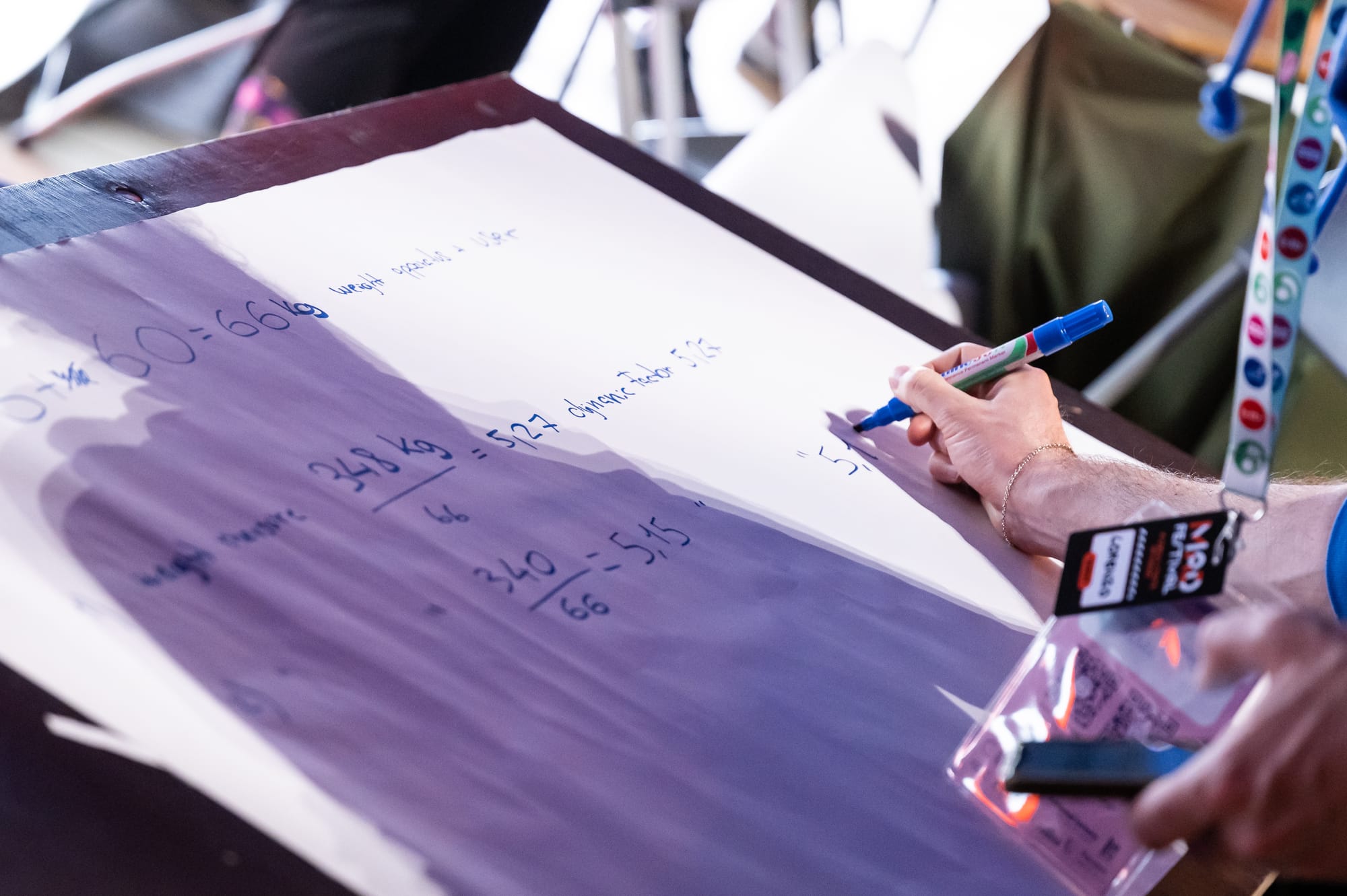
SAFE Teams
Within the circus sector itself, knowledge is further disseminated during so-called SAFE meetings, where participants from one of the safety courses assemble as a group of experts to exchange knowledge. How long will these meetings continue? It’s not set in stone yet. SAFE meetings are divided into the three main safety topics: technical, physical and psychosocial safety. The cherry on the knowledge-sharing cake was the international conference Circus – a safe(r) space for danger, where all the acquired knowledge and more were shared with a wide, international circus audience.
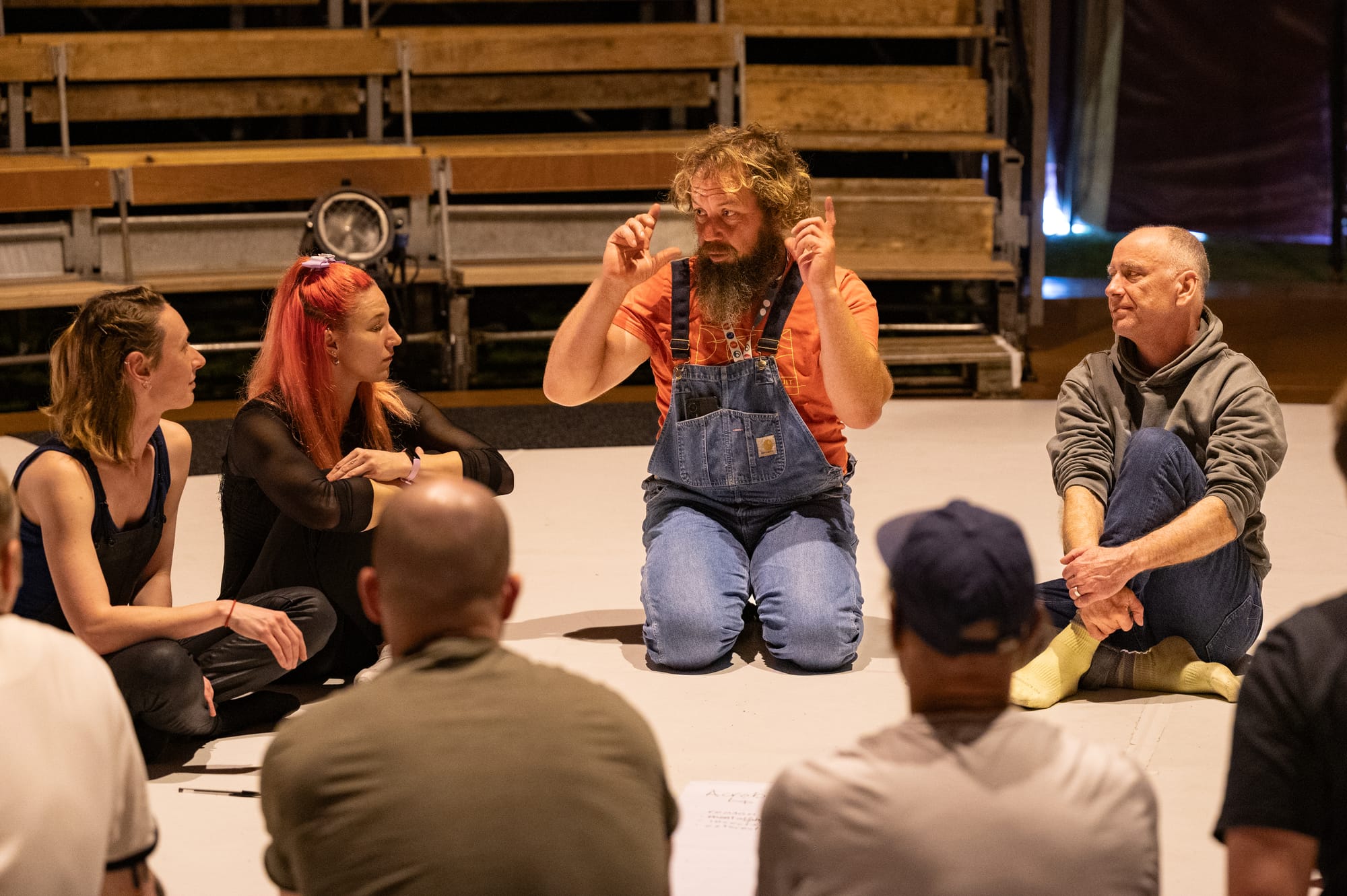
Safety in circus versus sport
Lowie Keppens (21) is one of the participants in the SAFE team for physical safety. ‘It’s unbelievable how much expertise is shared in the SAFE team. I have no doubt this will give a boost to the future of circus and physical safety.’
Lowie is studying physical education and movement sciences at KU Leuven with a specialisation in circus, and he will start his master’s degree in September 2024. He started out his circus career as a young boy at the youth circus SALTO. Since then he gained experience at the youth circus Cirkus in Beweging and he went to the circus high school in Leuven. After his completion of the circus arts instructors’ course (BIC), he is now a teacher himself, at Cirkus in Beweging Circus Atelier SALTO and Ell Circo D’ell Fuego.
He may still be very young, but he already has a long career in circus behind him. Has he noticed an increase in safety awareness in recent years? ‘There has always been an awareness of safety in the youth circuses, but in recent years there is clearly more effort being put into organising specific training and refresher courses for instructors: for both technical and psychosocial safety. That does give some peace of mind as an instructor. You try to always make lessons as safe as possible, but now there are specific tools for a safe approach for certain situations. That’s really reassuring. There’s also proper policy relating to administration and long-term planning now. One example is the QR code on the first-aid kit. Every time you use the kit, you scan the QR code and complete a short survey. This is to create an overview of any accidents, big or small, that may occur. Plus, at the end of a certain period, the prevention officer can use the list see which infrastructural changes are needed to make the venue safer.’
In your training, you’re also closely involved with the sports world. How are things in that world? Do you notice a difference with the circus world when it comes to safety? ‘In sports, the focus is more on the physical side of it, not so much on psychosocial safety. In that regard, circus is definitely a step ahead of the sports world. Here I’m mainly thinking about the non-professional side of both sectors. At the recreational level of sports such as football, everything is about competition, while in the youth circus world there is virtually no competition involved and so there is room to focus more on psychosocial safety. This means that participants in circus classes can develop more at that level due to that extra focus.’
Impact of the initiative, a testimonial
Jef Delva (25) started his circus career with Circus Without Hands (Brussels) before training as a technician. He now works with various circus companies such as Sinking Sideways, Circumstances, Bert Berg and Familiar Faces. Today he mainly deals with the buttons and cables of lighting and sound systems. Rigging is not part of his remit (yet). ‘I haven’t been trained in that. Although, needless to say, safety is a much broader topic than just rigging. In set building, too, it’s important to take a number of safety regulations into account.’
Jef is training as a well-being officer as part of the psychosocial safety course. ‘A very interesting course. I often notice technicians making unpleasant statements towards artists and I feel like although I want to respond to this, I don’t know the best way to go about it. If at work I hear someone making a very woman-unfriendly remark, who should I report it to, as a technician who works for multiple companies?’ Is that part of the duties of the technician? ‘It’s everyone’s duty. But as a technician, you do encounter it often and from my position it is easier to pretend I didn’t hear or see anything than it is to react. The training has given me certain tools that I can already start to apply. Not only in terms of responding in the correct way, but also in terms of signalling issues and referring people to others.’
Has the safety drive had a noticeable impact on the sector? ‘I notice that people are talking a lot more about psychosocial safety, so the impact is clearly there. Because talking about it is the first and the second step towards the systemic change that we are lacking today.’
*Measuring the impact of the educational safety drive
In the spring of 2024, an initial survey was conducted by Circuscentrum to measure the impact of the safety drive among the structurally subsidised youth circuses in Flanders, two years after the initiative was launched. It showed that, today, 75% of the subsidised youth circuses have a general safety policy, versus 25% at the start of the initiative. More than half the youth circuses also have a specific policy, in writing, relating to technical, physical and psychosocial safety. Most of the youth circuses already had various ‘safety roles’ prior to the start of the initiative. We observe a notable increase in the number of internal prevention officers and company first-aid providers compared to the numbers before the project began, but if we zoom in on this we see mainly a shift toward roles ‘with relevant training’.
There has also been a striking evolution in terms of equipment: before the start of the initiative, there was only an annual inspection of equipment at two youth circuses, but now it is done at seven of them. One final noteworthy observation is regarding the accident logbook: while most youth circuses had already had such a logbook for quite a while, it is only since the safety drive that the ‘near-accidents’ have also been logged, offering a new basis for accident prevention.
Author: Katrijn De Bleser
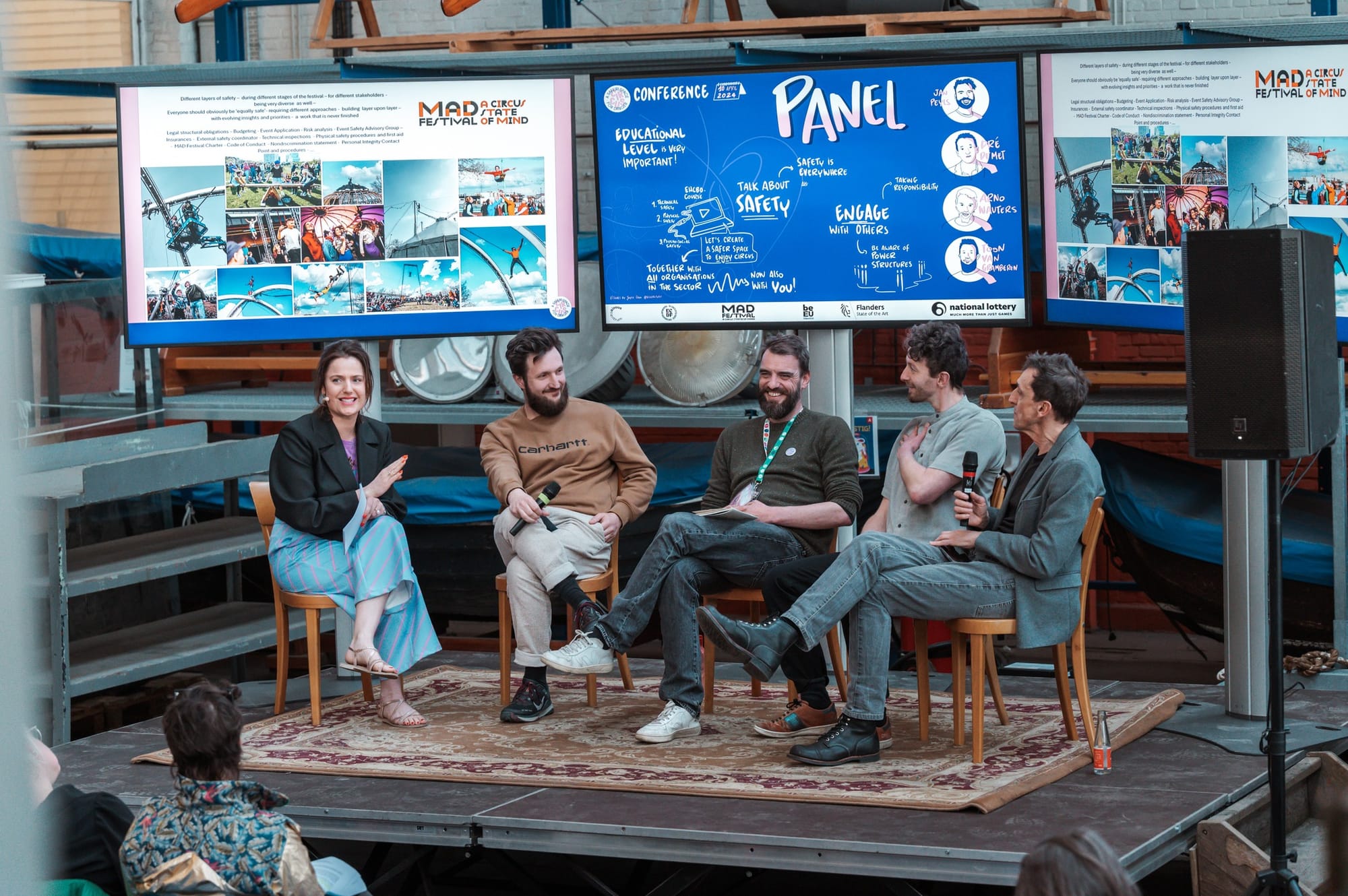
Flemish safety drive during the international conference 'Circus- a safe(r) space for danger'
Would you like to know more about the Flemish safety drive? Check out the panel conversation that was held during 'Circus- a safe(r) space for danger' and the compilation video with interviews with different participants to the activitities.
